
he extraordinarily successful firm of W. & R. Chambers was founded by two brothers – William (b. 1800) and Robert (b. 1802) – the sons of a moderately well-to-do cotton producer, employing at one time as many as a hundred individual hand-loom weavers, in the Southern Scottish town of Peebles. Both boys received a basic primary education at the local school, enhanced by input from the local bookseller, Alexander (“Sandy,” as the boys called him) Elder, “a decent man [. . .] enterprising and enlightened beyond the common range of booksellers in small country towns.” Elder had opened a circulating library, patronised by the boys’ father James Chambers, thanks to which they got to “read a considerable number of the classics of English literature” and “were made familiar,” in particular, “with the comicalities of Gulliver, Don Quixote, and Peregrine Pickle,” with “Pope’s translation of the Iliad,” with Fielding and Sterne, and with the fourth edition of the Encyclopaedia Britannica, purchased from Elder’s library by their father. William later paid generous tribute, in a Memoir of Robert Chambers published after Robert’s death in 1872, to his “friend Alexander Elder,” “in whom there was certainly something considerably superior to the common book-trader” and whose “catalogue included several books striking far above the common taste” (54-59). The two Chambers’ reading or “self-education,” as William termed it, was, however, haphazard and undirected:
With Elder’s field of literature laid open to us, Robert and I read at a great rate, going right through the catalogue of books without much regard to methodised study. In fact, we had to take what we could get and be thankful. Permitted to have only one volume at a time, we made up for short allowance by reading as quickly as possible, and, to save time, often read together from the same book. [. . .] Desultory as was this course of reading, it undoubtedly widened the sphere of our ideas; and it would be ungrateful not to acknowledge that some of my own success and not a few of the higher pleasures experienced in life are due to Elder’s library in the little old burgh. [pp. 58-59]
With the advent of steam looms in the manufacture of cotton James Chambers’ business fell upon hard times, however, and in 1813 the family had to move to Edinburgh where William was apprenticed to an Edinburgh bookseller for five years at four shillings a week.

William and Robert Chambers by J. R. Pairman and R. C. Bell. Detail of the frontispiece of the Memoir of Robert Chambers. Courtesy of the National Library of Scotland. Click on image to enlarge it.
Robert was able to continue his formal education for a bit, in the hope that he might attend the University and enter the ministry. A further deterioration in the family fortunes, however, put an end, in 1816, to Robert’s schooling also. The younger Chambers undertook some private teaching and served for a time as a junior clerk in commercial houses until, in 1818, at the age of sixteen, following his brother’s advice, he opened a bookstall for second-hand books on Leith Walk, the thoroughfare leading down from Edinburgh to the port at Leith. His stock consisted of the family book collection and his own schoolbooks. An expert calligrapher, he was able to augment the slim takings from his book sales by producing handwritten documents for special occasions, and a few years later he was to make a friend and ally of Walter Scott on presenting him, at the suggestion of John Constable, with a beautifully handwritten anthology of songs from The Lady of the Lake. On the occasion of George IV’s visit to Scotland, Scott obtained for Robert the assignment of writing out the Royal Society of Edinburgh’s address to His Majesty, for which he was, in his own words, “handsomely paid” (Traditions of Edinburgh, pp. ix-x).
A year after Robert opened his stall on Leith Walk, William, having completed his apprenticeship, did likewise, except that, thanks to a grant of ten pounds worth of books on credit, he focused on selling new books from the stall he had built himself. From the start he chose to sell books bound in inexpensive boards rather than leather or even cloth. Soon he was buying books in sheets, which he himself folded, sewed, and bound in boards “thereby saving on an average threepence to fourpence a volume.” Next he managed to acquire for three pounds an old hand press and a bundle of “dreadfully old and worn” types. With these he was able to undertake odd printing jobs and soon afterwards produced an edition of 750 copies, “small size, of the Songs of Robert Burns,” bound “with my own hands [. . .] in boards, with a coloured wrapper.” All copies were sold, Chambers later reported, clearing a profit of nine pounds (Memoir, pp. 152-55). Soon afterwards, in 1822, the twenty-year old Robert wrote and brother William printed and published a volume – Illustrations of the Author of Waverley – purportedly describing the real individuals on whom many of Walter Scott’s characters were based. Received by the public, according to the author, “with some degree of encouragement” (p. iii) this early work had a second edition in 1825, thanks to the striking success of the author’s next book, Traditions of Edinburgh (1825, originally published and sold in parts), which led Scott to express “astonishment as to where the boy got all the information” and shortly afterwards to call on the young writer with “sixteen folio pages, in his usual close handwriting, and containing all the reminiscences he could at the time summon up of old persons and things in Edinburgh” (p. v). The association developed over time into a friendship and the mature and celebrated Scott let himself be accompanied by the up and coming Chambers on his walks home from Parliament House in Edinburgh.
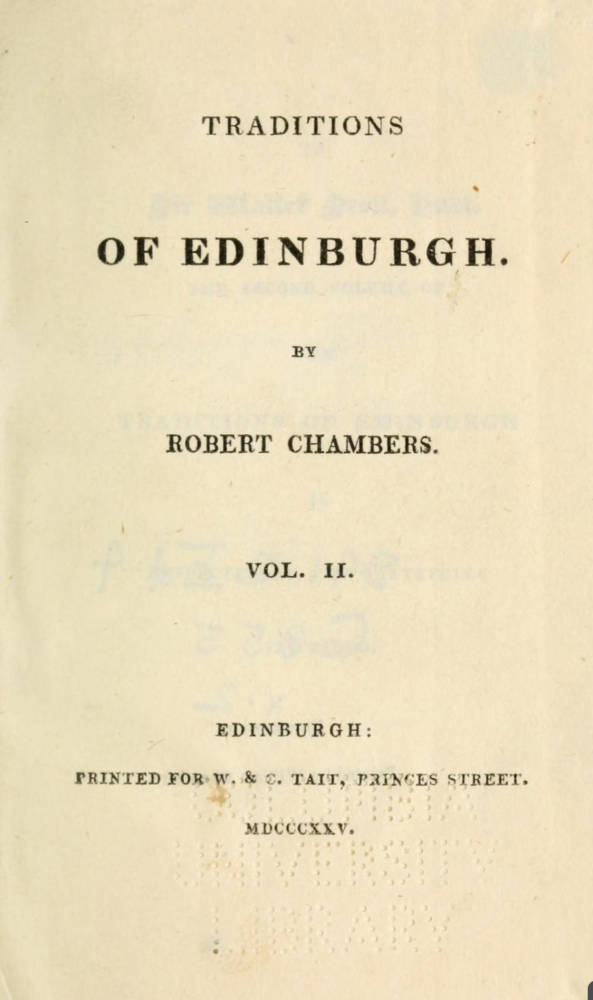


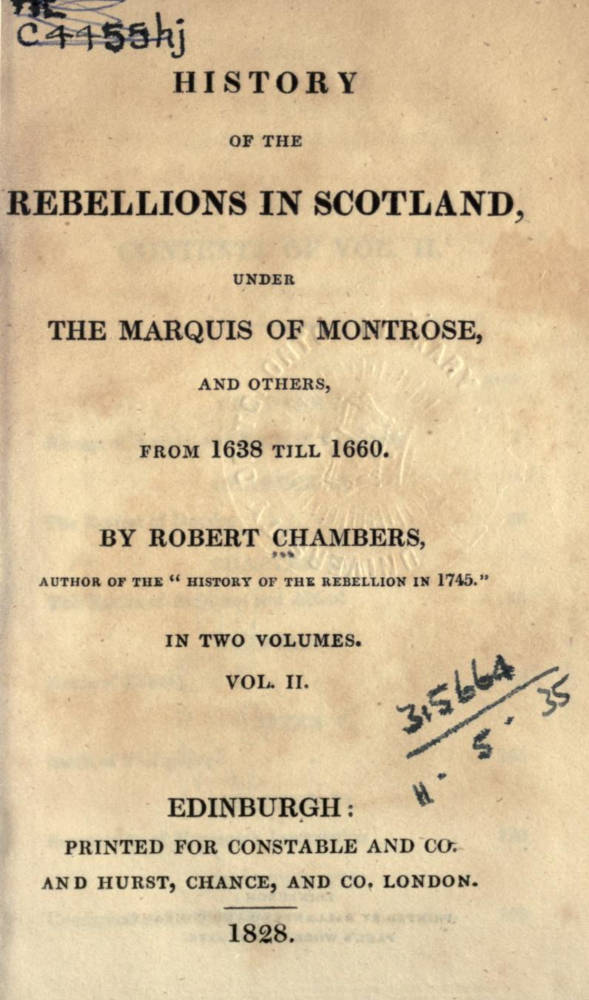
Three left: Various editions of Traditions of Edinburgh. Right: History of the Rebellions in Scotland. These page images and those below from the Internet Archive. [Click on images to enlarge them.]
In 1823, the brothers’ stock had increased enough to allow them to move to more substantial quarters in Edinburgh proper. Robert built on the success of Traditions of Edinburgh by composing a number of other books on Scottish subjects: Popular Rhymes of Scotland (1826) and, as parts of Constable’s Miscellany, a History of the Rebellion of 1745 (1828), followed by a History of the Rebellions in Scotland from 1638 till 1660 (also 1828) and a History of the Rebellions in Scotland in 1689 and 1715 (1829). Together the brothers produced a Gazeteer of Scotland (1832).
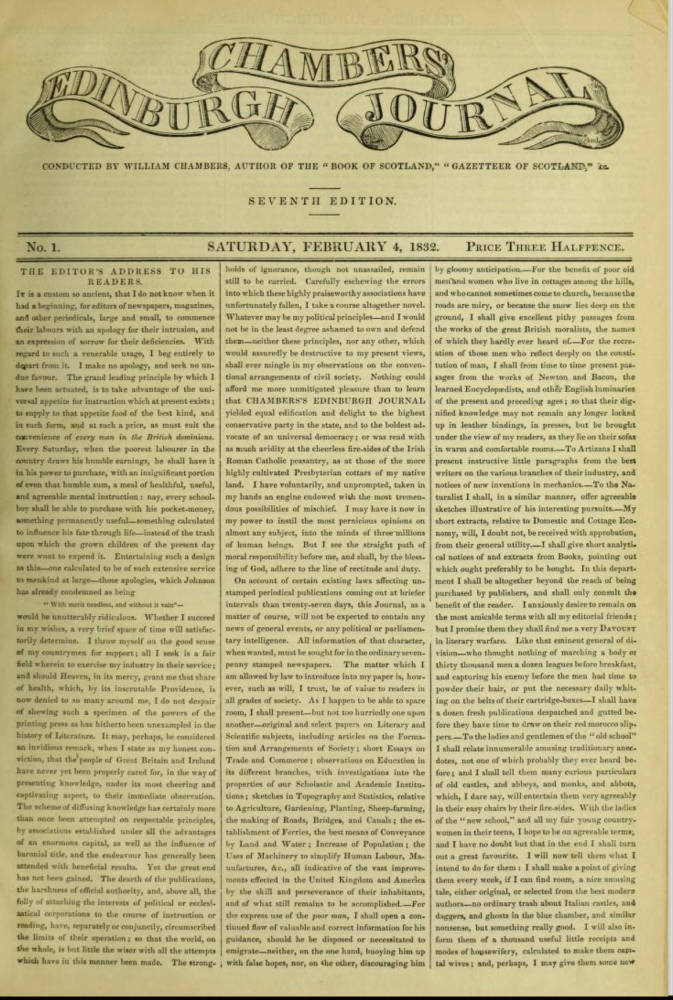

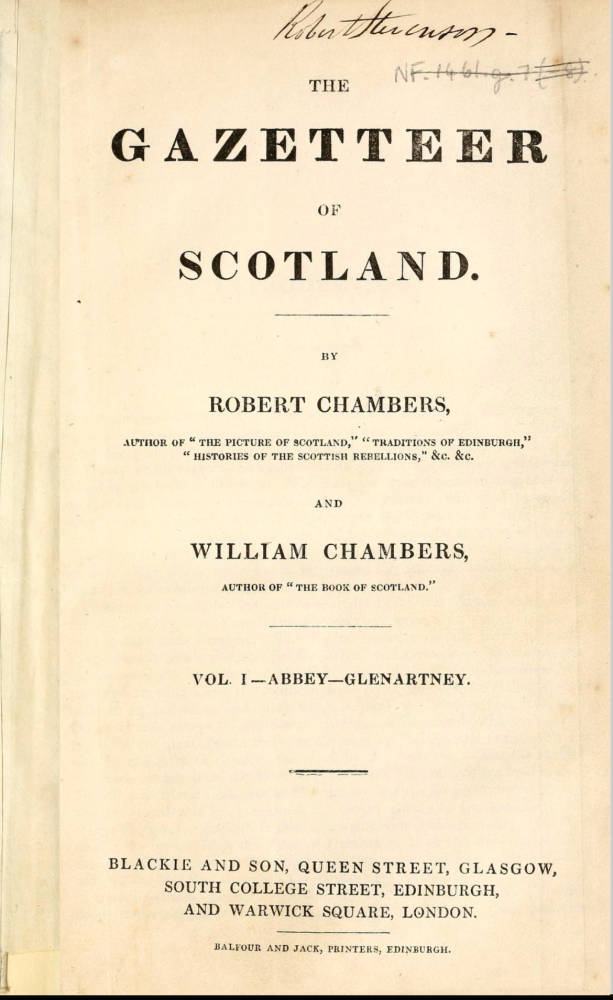

Left two: Chambers Edinburgh Journal. Right two: The Title-page and a two-page spread with illustration from The Gazetteer of Scotland. [Click on images to enlarge them.]
It was in 1832, however, that the Chambers brothers embarked on their as yet most significant venture. This was Chambers’s Edinburgh Journal, a low-price weekly periodical, consisting of eight folio pages (later reduced, for convenience, to royal octavo) printed in three columns each and priced at three-halfpence for each issue. The aim of the new journal, which was William’s idea and of which he was to be the managing editor, while the at first sceptical and reluctant Robert, serving (as of the fourteenth number) as the literary editor, was to offer instructive and entertaining essays and articles on a wide range of topics — literature, science, government, trade and commerce, education, agriculture, industry — in a form accessible to the mass readership thought to have been created by the new legislation affecting public education. At the same time, by including fiction and avoiding the promotion of particular political and religious agendas, the brothers hoped to distinguish their publication from the – so they claimed — more one-sidedly “edifying” journals that had preceded theirs.
The first number, issued on 4 February 1832, contained an opening address that is worth quoting at some length inasmuch as it outlines clearly the brothers’ motivations. That there was also no doubt an unspoken aim of tapping into a potentially lucrative market need not invalidate the nobler motivations presented in the address:
The principle by which I have been actuated, is to take advantage of the universal appetite for instruction which at present exists; to supply to that appetite food of the best kind, in such form and at such price as must suit the convenience of every man in the British dominions. Every Saturday, when the poorest labourer in the country draws his humble earnings, he shall have it in his power to purchase with an insignificant portion of that humble sum, a meal of healthful, useful, and agreeable mental instruction. [. . .] It may perhaps be considered an invidious remark when I state as my humble conviction, that the people of Great Britain and Ireland have never yet been properly cared for, in the way of presenting knowledge under its most cheering and captivating aspect, to their immediate observation. The scheme of diffusing knowledge has certainly been more than once attempted. [. . .] Yet the great end has not been gained. The dearth of the publications, official inflexibility, and above all the plan of attaching the interests of political or ecclesiastical parties to the course of instruction of reading, have separately or conjunctly circumscribed the limits of the operation; so that the world, on the whole, is but little the wiser with all the attempts that have been made. [. . .] Carefully eschewing the errors into which these praiseworthy associations have fallen. I take a course altogether novel. Whatever may be my political principles, neither these nor any other which would be destructive of my present views, shall ever mingle in my observations on the arrangements of civil society. [p. 227].
Within a few days, William relates, the magazine had sold thirty thousand copies in Scotland alone and “shortly afterwards, when copies were assigned to an agent in London [. . .] the sale rose to upwards of fifty thousand, at which it long remained. Some years afterwards, the circulation exceeded eighty thousand” (p. 228). By comparison, “Blackwood’s Magazine and the Quarterly Review, aiming at a more prosperous audience, averaged sales of less than 10,000 copies during the same period” (Frye, p. 86). In his Memoir of Robert Chambers, William cites with pride a letter, dated 27 October 1832, which Robert received from a correspondent living in England and which presents a no doubt somewhat romanticized picture of the extraordinary success of the Journal: “My wife, who has just returned from Scotland, says that your Journal is very popular among her native hills of Galloway. The shepherds, who are scattered there at the rate of one to every four miles square, read it constantly, and they circulate it in this way: the first shepherd who gets it reads it, and at an understood hour places it under a stone on a certain hill-top; then shepherd the second in his own time finds it, reads it, and carries it to another hill, where it is found like Ossian’s chief under its own grey stone by shepherd the third, and so it passes on its way, scattering information over the land” (p. 237). (The author of the letter, Allan Cunningham, was a Scottish poet and novelist and the author of The Lives of the Most Eminent British Painters, Sculptors and Architects, 1829-33.) William was too smart, however, and too authentically committed to his project of raising the cultural and intellectual level of the working masses not to grasp the real character of the journal’s popularity. “This paper is read, we believe,” he admitted in the issue of 25 January, 1840, “by a class who may be called the élite of the labouring community; those who think, conduct themselves respectably, and are anxious to improve their circumstances by judicious means. But below this worthy order of men, our work, except in a few particular cases, does not go. A fatal mistake is committed in the popular notion that the lower classes read. There is, unfortunately, a vast substratum in society, where the printing-press has not yet unfolded her treasures” (Quoted Frye, p. 87). About the Journal’s success in the higher ranks of society, in contrast, there is little doubt. It was read and appreciated by writers of distinction, such as Charlotte Brontë, Leigh Hunt, Thomas De Quincey and Harriet Martineau (Thomas, p. 2).
In 1854 the title of the journal was changed to Chambers’s Journal of Popular Literature, Science, and Art and in 1899 to Chambers’s Journal, as which it survived until 1956. Its basic character did not change, however, and its “passing” was “regretted” in the London Times “as that of a distinctive journal which has played a memorable part in the history of periodical literature for more than 120 years” (Thomas, p. 1).
During the early years, in addition to many essays by Robert, the Journal published work by Maria Edgeworth, John Galt, and the poet Thomas Hood. Though most of the innumerable nineteenth-century contributors of novels and short stories are little known or almost completely forgotten today, including the extraordinarily productive and popular James Payn (1830-1898), who served as editor of the Journal from 1860 to 1875, literary adviser to the firm of Smith, Elder & Co., and editor of that company’s Cornhill Magazine as of 1883, and who is represented in the journal between 1854 and 1874 by no fewer than seventeen novels in instalments in addition to countless short stories, Chambers’s did publish literary fiction by a number of writers still remembered and occasionally read today, such as Leslie Stephen (three short stories in 1866), Margaret Oliphant (A House Divided Against Itself, in forty-eight instalments, 1885), the astonishingly prolific Walter Besant (The Ivory Gate, in thirty-nine instalments, 1892 and The Master Craftsman, in twenty-six instalments, 1896), and John Buchan (John Burnett of Barns: A Romance, in twenty-six instalments. 1897-98). In addition, George Meredith’s first published work, the poem “Chillianwallah” appeared in 1849, Thomas Hardy’s “How I Built Myself a House” in 1865, and Arthur Conan Doyle’s “The Mystery of Sasasssa Valley” in 1879, while the author was still a medical student at Edinburgh University.
It does appear that while Robert strongly supported the journal’s literary selections and the fictional writings and editorial policies of James Payn in particular, he had to defend them against the reservations of William, who remained faithful to his original goals and complained of the levity of the popular literature appearing in the journal. While Payn’s serialised novel The Family Scapegrace (1861), for instance, was apparently well received by the journal’s readers and had been read in advance and approved by Robert, William, as Payn himself reports, “objected to it on the ground of its ‘lightness.’ He would have preferred the subject of wild beasts to have been more ‘intelligently treated;’ their various habitats to be described, and some sort of moral to be deduced from them” (Payn, p. 194).
William’s view of his role as a publisher was in fact never abandoned. In 1833-1835, as the Journal was taking off, the brothers launched another project. Information for the People — issued in one hundred fortnightly parts priced at three-halfpence each and then published as a volume in 1835 — was intended, in the words of the preface to the 1842 edition, “to place a work of the character of an encyclopedia really within the reach of the working-classes and those next above them” while selecting “only the subjects on which it is important that the classes in question should be informed.” In accessible language free of technical detail, the articles were to cover “the most important branches of science, physical, mathematical, and moral, natural history, political history, geography, and literature.” In this way, “all is given which, if studied and received into the mind, would make an individual of those classes a well-informed man” (Quoted Frye, p. 87). By 1874-75 the work had gone through five editions with more than 170,000 copies sold and a French translation issued in Paris.
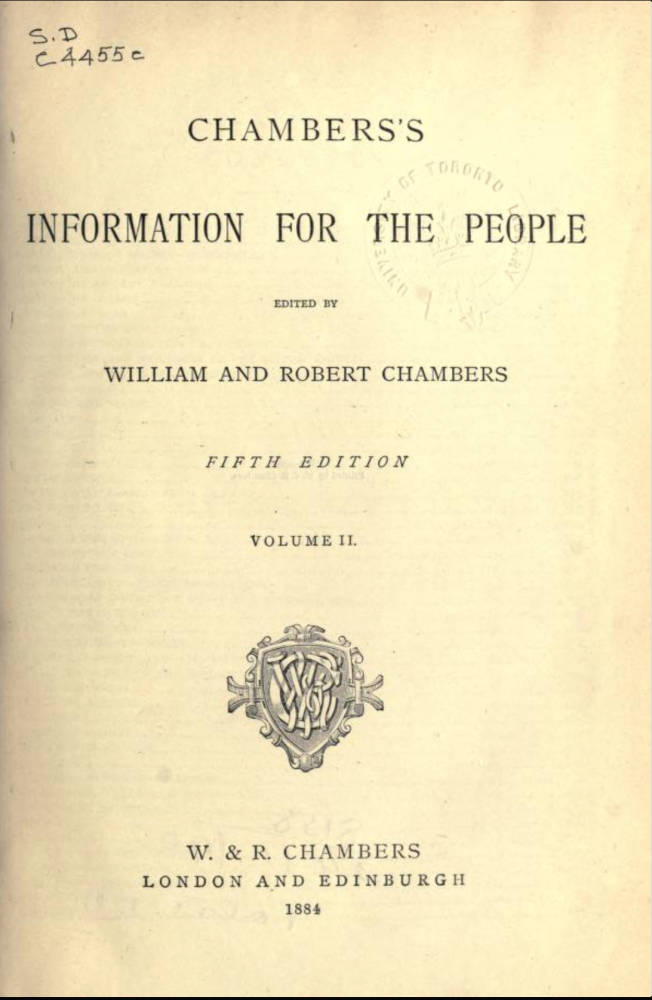
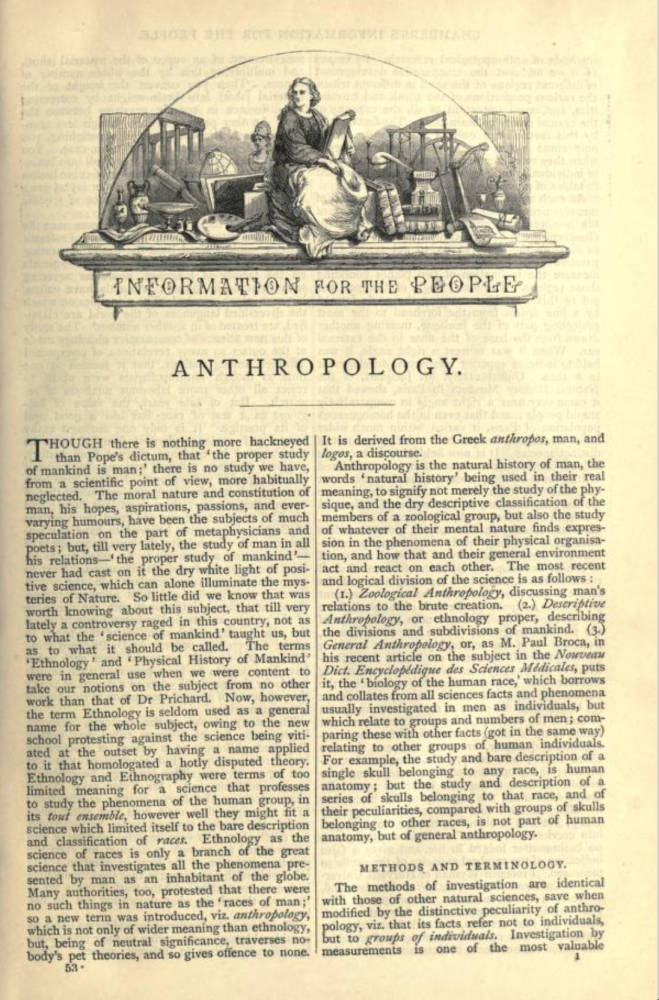
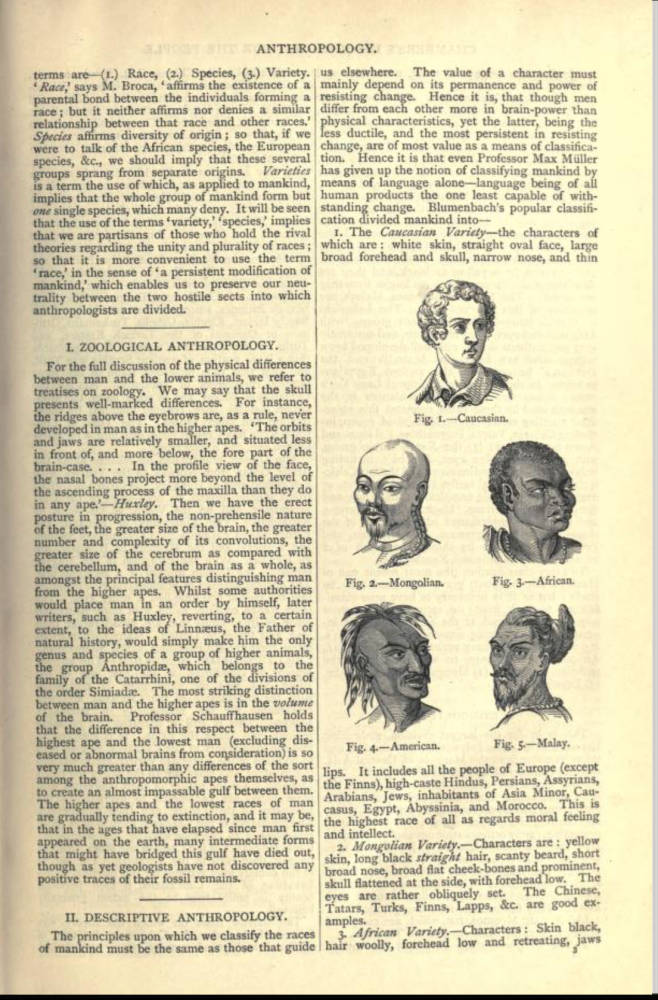


Sample pages from Information for the People. [Click on images to enlarge them.]
The success of Information for the People encouraged the Chambers brothers to pursue similar projects. In 1835 a still larger project was announced – Chambers’s Educational Course, a series of treatises and schoolbooks, ultimately numbering 306 parts, issued at various intervals until 1896. The series largely reflected Scottish educational practice and many of the volumes were in fact written by teachers in Scottish schools. It was one of the first schoolbook series to include the physical sciences and maps. As a contemporary noted in 1873, “this series begins with a three-halfpenny infant primer, and goes onward through a whole library of grammars, dictionaries, histories, scientific, and all primary class books, and cheap editions of standard foreign and classical authors, until it culminates in a popular ‘Encyclopaedia in ten thick volumes”’ (p. xv). Anticipating Blackie, Collins, and Nelson, the brothers launched their People’s Editions of standard authors in 1838; by 1840 the series already numbered thirty-two volumes of inexpensive reprints, including works by Addison, Bacon, Burns, Crabbe, Defoe, Franklin, Goldsmith, Locke, Ramsey, Scott, and Smollett. This was followed in 1842-43 by a Cyclopaedia of English Literature: A History, Critical and Biographical, of British Authors, in All Departments of Literature, Illustrated by Specimens of Their Writings, published in eighty-six weekly parts at the by then expected price of three-halfpence each, and in 1844 as a two volume set in royal octavo. Largely the work of Robert Chambers but inspired by William’s goal of “improvement” the Cyclopaedia effectively wove a carefully prepared set of “extracts from our national authors” into a history of British literature. Within a few years 130,000 copies had been sold and four editions had been put out by the end of the century, with a fifth in 1910, to which well-known writers like George Saintsbury and Andrew Lang contributed. New editions continued to be put out until 1938. Finally, between 1860 and 1868 the brothers produced what they called their “crowning achievement in cheap and instructive literature.” This was Chambers’s Encyclopaedia: A Dictionary of Useful Knowledge, originally published in 520 weekly numbers at the usual three-halfpence each and then as a ten volume reference work. Based on the celebrated German Brockhaus Konversations-Lexikon (1838-41), which was adapted to rather than translated for English-speaking users, this work again aimed to avoid elaborate, highly technical treatises on various topics and to provide instead readily accessible and relatively short entries suitable for the general reader by a hundred contributors. It turned out to be a great success, as well as a highly profitable venture. A revised edition appeared in 1888-92, and a third in 1923-27. As recently as 1955 yet another revised edition came out, albeit with a different publisher, by arrangement with the Chambers company. In the present writer’s youth, Chambers’s Cyclopedia was far more accessible and widely consulted than the massive and unaffordable Encyclopaedia Britannica.
While both Chambers brothers produced books of their own and each had his own interests and inclinations – Robert’s being perhaps more literary and historical, William’s more scientific and practical — their close partnership, to which William’s Memoir of the life of his brother bears eloquent witness, facilitated a broadly conceived pursuit of the goal of intellectual and moral improvement originally set forth by William. At the same time, sound business practices and decisions ensured handsome profits and the continued viability of the company. Like Collins and Nelson, W. & R. Chambers did more to spread knowledge and understanding of the literary canon than, like Murray and Smith and Elder, to promote new literary talents.
Spreading the Word: Scottish Publishers and English Literature 1750-1900
- Scotland and the Modern World: Literacy and Libraries
- Scottish Publishers, London Booksellers, and Copyright Law
- Andrew Millar (London) 1728
- William Strahan (London) 1738
- Robert and Andrew Foulis, The Foulis Press (Glasgow) 1741
- John Murray (London) 1768
- Bell & Bradfute (Edinburgh) 1778
- Archibald Constable (Edinburgh) 1798
- Thomas Nelson and Sons (Edinburgh) 1798
- John Ballantyne (Edinburgh) 1808
- William Blackwood (Edinburgh) 1810
- Smith, Elder & Co. (London) 1816
- William Collins (Glasgow) 1819
- Blackie and Son (Glasgow) 1831
- W.& R. Chambers (Edinburgh) 1832
- Macmillan (Cambridge and London) 1843
- Lesser Publishers
- Eighteenth- and Nineteenth-century British Copyright Law: A Bibliography
Bibliography
Chambers, William. Memoir of Robert Chambers, with autobiographical reminiscences of William Chambers. 8th ed. Edinburgh and London: W. & R. Chambers, 1874.
Chambers, William. Traditions of Edinburgh (1825). new edition (London and Edinburgh: W. & R. Chambers, 1868.
Frye, Lowell T. “W. and R. Chambers.” in Dictionary of Literary Biography. vol. 106. British Literary Publishing Houses, 1820-1880. Detroit and London: Gale Research, 1991. Pp. 83-91.
Illustrations of the Author of Waverley, Being Notices and Anecdotes of Real Characters, Scenes, and Incidents Supposed to be Described in His Works. Edinburgh: John Anderson, Jun., 1825.
Payn, James. Literary Recollections. 3rd ed. London: Smith, Elder, 1884.
Thomas, Sue. Indexes to Fiction in Chambers’s Journal of Popular Literature, Science, and Art, later Chambers’s Journal, 3rd to 6th series of Chambers’s Edinburgh Journal, 1854-1910. Victorian Fiction Research Guides VII. University of Queensland, 1989.
Last modified 28 September 2018